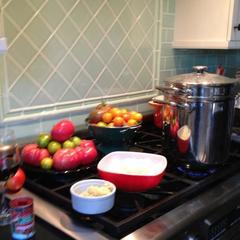it does appear the board has a finish on it - I don't see any flaking around the worn&fuzzy areas - so probably a drying oil. tung oil is one guess.
does not appear to have been stained - stains usually accumulate in places like the corners of the edge rabbiting (making a darker corner)
where (geographically / continent wise) did the board come from originally? Europe/North America have different species . . . Spekva is Danish(?) so I'm suspecting a European species.
does it feel "light" for it's size - 'normal' or 'heavy'?
no obvious joints - given the clear width and ultra-straight grain its likely "old growth" i.e. from a bigbig tree
generically it's a "face grain" construction - but well seasoned and selected, because that width and thickness is prone to warping / cupping.
it is essential / critical to use/store/keep the board where both sides dry evenly. for everyday use feet on the underside to keep the bottom from getting soaking wet dry would be a reasonable thing.
on-going - a light sanding with 200-300 grit sandpaper will even out the appearance - it's darkened with age (patina) so sanding will make the top surface lighter - which you may or may not want. I'm fond of mineral oil for a water resistant finish - easy to do / re-do / maintain. but do note, 'refinishing' the top will produce a lighter color - if you're fond of the 'old shopworn look' - a buffing with a plastic scrubbie type pad (3M makes a wood finish purpose style) would have minimal impact. re-creating a color match to an aged patina in a food safe finish will require some skills - probably best done by a professional....




